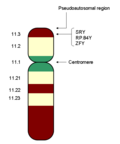Sex differences in human physiology: Difference between revisions
CSV import |
CSV import |
||
| Line 33: | Line 33: | ||
{{anatomy-stub}} | {{anatomy-stub}} | ||
== Sex differences in human physiology == | |||
<gallery> | |||
File:Human_Body.jpg|Human Body | |||
File:YChromShowingSRY2.png|Y Chromosome Showing SRY | |||
File:Gray241.png|Gray's Anatomy Plate 241 | |||
File:Gray242.png|Gray's Anatomy Plate 242 | |||
File:Woman_showing_fullness_of_cheeks.jpg|Woman showing fullness of cheeks | |||
File:Woman_redhead_natural_portrait.jpg|Woman redhead natural portrait | |||
File:Male_anatomy_1.png|Male anatomy | |||
File:Scheme_female_reproductive_system-en.svg|Scheme of female reproductive system | |||
File:1116_Muscle_of_the_Perineum.jpg|Muscle of the Perineum | |||
File:Lobes_of_the_brain_NL.svg|Lobes of the brain | |||
</gallery> | |||
Latest revision as of 20:51, 25 February 2025
Sex differences in human physiology are distinctions of physiological characteristics associated with either male or female humans. These can be of several types, including direct effects of sex chromosomes, secondary effects of gonadal steroids, or gender effects related to differential social roles.
Sex chromosomes and phenotype[edit]
Sex chromosomes (X and Y) carry genes that code for different physical traits and are one of the forces establishing sex differences in humans. The Y chromosome carries genes related to the development of male sexual characteristics, while the X chromosome carries genes important for both sexes.
Gonadal steroids[edit]
Gonadal steroids also play a crucial role in sex differences in human physiology. These hormones, which include estrogens, progesterone, and androgens, are produced in different amounts in males and females, and they influence the development and function of various body systems.
Gender and social roles[edit]
Gender and social roles can also influence human physiology. For example, societal expectations can influence behaviors such as diet, exercise, and risk-taking, which in turn can affect health outcomes.
Sex differences in specific physiological systems[edit]
Cardiovascular system[edit]
There are several sex differences in the cardiovascular system. For example, men tend to have larger hearts and higher blood pressure, while women are more likely to experience certain types of heart disease.
Endocrine system[edit]
The endocrine system also shows sex differences. For example, women have higher levels of estrogen and progesterone, while men have higher levels of testosterone.
Nervous system[edit]
Sex differences in the nervous system include differences in brain structure, neurotransmitter levels, and responses to stress.
See also[edit]
References[edit]
<references />
Sex differences in human physiology[edit]
-
Human Body
-
Y Chromosome Showing SRY
-
Gray's Anatomy Plate 241
-
Gray's Anatomy Plate 242
-
Woman showing fullness of cheeks
-
Woman redhead natural portrait
-
Male anatomy
-
Scheme of female reproductive system
-
Muscle of the Perineum
-
Lobes of the brain










